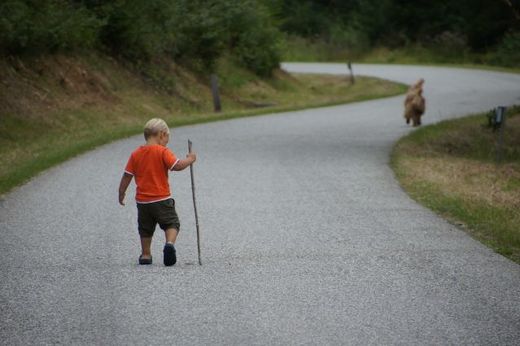
The awe and wonder of childhood
My son recently asked me if it was possible that we lived on a speck of dust in a much larger universe. He explained that he had just watched
Horton Hears a Who again and it had him thinking. I, ever eager to promote the impossible, said I don't see why not. And he walked about blissfully conjuring the possibilities.
What is it about fantastic speculation that makes it so compelling a past time? Many of us read science fiction, or watch documentaries about aspects of our world that we will never experience, and yet we love it. We love to hear that there may be parallel universes or ways to go back in time. I recently read an
article (link is external) in
National Geographic magazine that argued that we may live in the center of a black hole, created in a multiverse, where black holes that experience just the right conditions expand into universes like our own—as if they were flowers. I felt like I had taken mescal after reading that article. I walked around for a week just smiling at everything.
But why?
To my knowledge, no other species cares if we live inside or outside of a blackhole. No other species considers it interesting that quantum probability requires something to collapse the wave function (like consciousness) or else that there are many worlds, infinite and ever increasing parallel universes in which every possibility happens. All of these theories are like
drugs—like mind-expanding mushrooms that open Huxley's doors of perception. They each carry with them such a fantastic vision of reality that
we are forced to rethink our place in the universe and thereby the limits of who we are as individuals, as a species, and as life itself. What is it that makes this capacity for wonder possible?
The answer lies in part in how we understand ourselves.
Let me explain.
Episodic future thinkingSince about the mid-1990s researchers began to identify cells in the hippocampus that were active when animals 'thought about' places they were about to visit. In some of the initial studies, rats were found to reactivate sequences of place cells in their hippocampus during
sleep that were also actived together when the animals were awake. This animal
dreaming has since been found to occur when animals need to make a difficult decision about where to go next. In these case, the animals reactivate past
memories such they can search their memory for the best way forward. This is called
episodic future thinking and it is
deeply related to our ability to deliberate about the future (see Pezzulo et al., 2014).
Even more interesting is the observation that animals can activate new sequences in their minds that are plausible, but have nonetheless never been experienced. Now the animal isn't just remembering, it is creating a model of its world. Within that model, the animal can conjure up a future that is custom built to its own specifications. This self-projection has often been speculated to be the domain of humans alone, but we now know it isn't so.
Hugging your virtual momBuildig a model of the world in our heads allows us to simulate reality. This idea is supported by the
simulation theory of cognition. Hesslow (2002) has done a lot of work outlining this theory, but the basic idea is fairly simple. If the mind can use its own output as new input, then it can simulate reality. We can imagine that we are going on vacation, getting hit by a bus, or falling in love. When we do this, areas in our
brain are activated that are associated with our actual experience of realities similar to the one we envision—both in sensory and motor areas—and their probable outcomes are activated as well. If we imagine playing the piano, our brain wiggles our cognitive fingers. If we imagine flying to the moon, our brain looks out the window at the shrinking blue earth in our minds. Just imagine giving your mom a hug, and immediately consequences begin to proliferate in your mind. Your brain is hugging your virtual mom, who is in turn virtually hugging you back.
We are our model of the worldNow what's quite important here is something you may have missed. If the animal is building a model of its world, then it is also building a model of itself.
That is, to the extent that we think we are anything, we must do so in relation to what we understand about the place, the world, the universe in which we live. As our understanding of that place changes, we change as well.Indeed, arguably one of the most significant contributions of psychology is that
our understanding of ourselves is more defined by what we believe in our heads than by the actual external world that we experience. If you imagine you are the center of the universe, then you experience yourself as a different person than one who imagines they live on a speck of dust. However, even better, if you can imagine living in different kinds of universes, then who you are becomes a fantastic landscape of possibilities.
The wonder of science and art lies in their capacity to alter our model of the world, and thereby alter our conception of ourselves.
When I read today
in Quanta Magazine (link is external) that physicists at University College London were looking for evidence of other universes by looking for dents in ours, detectable by concentric rings in the cosmic background radiation of our universe, I swooned. In that moment, my brain simulated something like a child blowing bubbles, and our universe, somehow being one among many, in a vast inflationary process that breathes out worlds in countless varieties, each with various versions of things like me. And then my mind just popped.
History of the English Language
Published on Jan 15, 2015
A complete history of the English language !